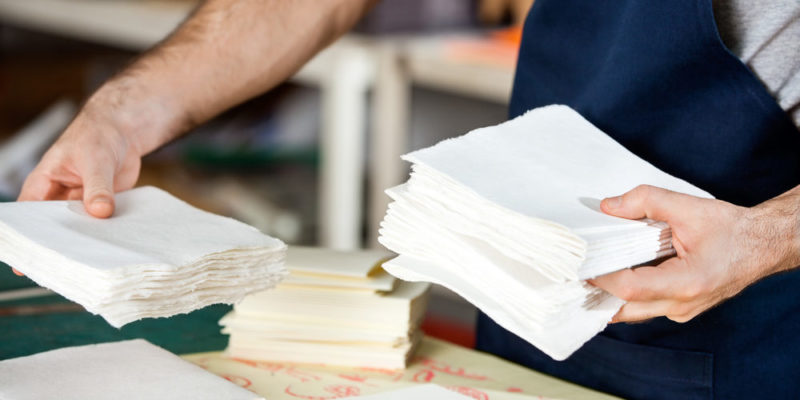We explain what paper is, its types of resistance and manufacturing stages. In addition, its general characteristics and causes of deterioration.
What is paper?
Paper is a thin sheet made from cellulose pulp . Cellulose is a mixture of vegetable fibers that are ground, suspended in water that then hardens when dried.
The paper can be manufactured by hand or industrially . Attempts to manufacture paper are recorded from the 3rd century BC. C., from textile fibers, in China . It was only in the year 610 after Christ that paper making spread to Japan and later, through the Arabs, it reached Europe.
Paper Whiteness

When a paper is white, it can be due to one of two factors:
- plain white A paper has a natural whiteness if it is produced from white fibers. The white of these papers is stable over time and is therefore preferred by artists.
- Bleached. It means that the cellulose has been bleached during the manufacturing process. An optical brightening agent is used for this. These papers yellow over time.
Paper Gloss
A paper can be glossy, matte, or satin , to varying degrees. The degree of brightness of the paper depends on the drying process as well as the fillers used in its manufacture. Fillers are powder products that are distributed over the powder to produce various effects.
Paper Strength Types

A paper has different types of resistance:
- Mechanical strength. It is the ability of the paper to physically resist a load.
- Resilience. The ability of paper to return to its original shape after being deformed.
- Dimensional stability. A paper is stable when, despite variations in environmental conditions (humidity, heat, etc.), it maintains its original shape.
- Durability. It is the paper's ability to withstand continuous and prolonged use.
Paper Opacity
Opacity can be seen by looking at a paper against the light , and an opaque (opposite of transparency) paper should not be confused with a matte (opposite of gloss) paper. If the opacity is well distributed throughout the paper, it is a good quality paper. This characteristic depends on several factors, such as the size, the fillers and pigments used and the refining of the paste.
Paper Density

It is the relationship between thickness and grammage, the higher the grammage and the lower the thickness, the greater the density.
- Thickness. It is the thickness of the paper. The unit of measurement is the micron.
- Grammage. It is the weight of the paper measured in grams per square meter. For a sheet of cellulose to be considered paper (and not cardboard or cardboard) it must have a grammage of up to 200 grams per square meter.
Fibers
 Fibers are the raw material that makes up paper and have various characteristics:
Fibers are the raw material that makes up paper and have various characteristics:
- Source. The fibers can come from fabrics such as cotton or linen (textile fibers), wood , cereals or hemp (vegetable fibers), or even recycled paper.
- Orientation. It is the direction in which the fibers are aligned during manufacturing.
- Length. Depending on their origin, the fibers can have various lengths. For example, cotton pulp fibers are long.
Paper gluing
The sizing is carried out during the manufacture of the paper, during which hydrophobic products (which move away the water molecules) are added , which can be resin glues, gelatin, reinforced glues and other fixing products. Its function is to prevent the penetration of liquids into the paper, that is, they reduce its absorbency.It can be done at two different times of manufacturing:
- Mass. This is what the mixture of the sizes with the paper pulp is called.
- On surface. The size is distributed on the surface of the paper when the sheets are already dry.
Grain
The roughness of the paper surface is called grain. It can be coarse, medium, fine or extra fine.
Paper Deterioration
 There are several factors that deteriorate the quality of paper. The effect of these factors depends on the conservation and resistance of the paper in the aspects already mentioned.
There are several factors that deteriorate the quality of paper. The effect of these factors depends on the conservation and resistance of the paper in the aspects already mentioned.
- Humidity and temperature . Changes in smoke and temperature can cause fungi , degradation, change in dimensions, ripples or make it brittle. Oxidation and warping can be caused by excess moisture.
- Light . Light can weaken paper by breaking down the cellulose chains, as well as discolor paper if it was made with inks or pigments.
- pests. Various insects feed on the paper (bookworms, lice, cockroaches) as well as rodents.
- Acidity. Acidity makes the paper more brittle. It can be caused by external contaminants or by the composition of the paper itself.
- Stains. They can be caused by external elements or by impurities in manufacturing.
Paper manufacturing stages
 The manufacture of paper currently has several stages:
The manufacture of paper currently has several stages:
- Pulp. It is created from the fibers. They are first sorted (by fiber type), washed, in some cases bleached, and then placed in water.
- Refined. The pulp fiber can be chopped or left whole, depending on the type of paper you want to make.
- Glued. When mass gluing is done, it is done after refining.
- Loads. After gluing, the products that will have an effect on the gloss, resistance, thickness and opacity are added.
- pigments. They can be added to the pulp or at the end of the process on the surface.
- Water removal. After going through these processes, the pulp is placed in a machine that removes the water through different procedures: gravity , vacuum, pressure and drying.
- The pressure. It is done through presses that, in addition to helping to remove water, determine the thickness of the sheet of paper.
The above content published at Collaborative Research Group is for informational and educational purposes only and has been developed by referring to reliable sources and recommendations from technology experts. We do not have any contact with official entities nor do we intend to replace the information that they emit.
Luke is passionate about fostering student involvement and connection. He studied psychology for his major and likes learning about the past. Luke aims to specialize in artificial intelligence and cybersecurity. .
Leave a reply
Your email address will not be published. Required fields are marked *Recent post

Sport: What Is It, Types, Risks, Features, Characteristics and Examples

Dogs: Emergence, Features, Characteristics, Feeding and Breeds

Story: Definition, Elements, Structure, Features and Characteristics

